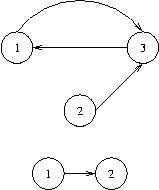POJ 2553 The Bottom of Graph 强连通图题解
栏目:互联网时间:2014-11-20 08:45:15
Description
We will use the following (standard) definitions from graph theory. Let V be a nonempty and finite set, its elements being called vertices (or nodes). Let E be a subset of the Cartesian product V×V, its elements being called edges.
Then G=(V,E) is called a directed graph.
Let n be a positive integer, and let p=(e1,...,en) be a sequence of length n of edges ei∈E such that ei=(vi,vi+1) for a sequence of vertices(v1,...,vn+1). Then p is called a path from vertex v1 to vertex vn+1 in G and we say that vn+1 is reachable from v1, writing (v1→vn+1).
Here are some new definitions. A node v in a graph G=(V,E) is called a sink, if for every node w in G that is reachable from v, v is also reachable from w. The bottom of a graph is the subset of all nodes that are sinks, i.e., bottom(G)={v∈V|?w∈V:(v→w)?(w→v)}. You have to calculate the bottom of certain graphs.
Let n be a positive integer, and let p=(e1,...,en) be a sequence of length n of edges ei∈E such that ei=(vi,vi+1) for a sequence of vertices(v1,...,vn+1). Then p is called a path from vertex v1 to vertex vn+1 in G and we say that vn+1 is reachable from v1, writing (v1→vn+1).
Here are some new definitions. A node v in a graph G=(V,E) is called a sink, if for every node w in G that is reachable from v, v is also reachable from w. The bottom of a graph is the subset of all nodes that are sinks, i.e., bottom(G)={v∈V|?w∈V:(v→w)?(w→v)}. You have to calculate the bottom of certain graphs.
Input
The input contains several test cases, each of which corresponds to a directed graph G. Each test case starts with an integer number v, denoting the number of vertices of G=(V,E), where the vertices will be identified by the integer
numbers in the set V={1,...,v}. You may assume that 1<=v<=5000. That is followed by a non-negative integer e and, thereafter, e pairs of vertex identifiers v1,w1,...,ve,we with
the meaning that (vi,wi)∈E. There are no edges other than specified by these pairs. The last test case is followed by a zero.
Output
For each test case output the bottom of the specified graph on a single line. To this end, print the numbers of all nodes that are sinks in sorted order separated by a single space character. If the bottom is empty, print an empty line.

Sample Input
3 3
1 3 2 3 3 1
2 1
1 2
0
Sample Output
1 3
2
题意的本质是查找没有出度的强连通子图,没有出度就是sink,the bottom of graph了。
就是利用Tarjan算法求强连通子图,并要用标识号标识各个强连通子图,然后记录好各个顶点属于哪强连通子图。
程序带详细的注解:
#include <stdio.h>
#include <stdlib.h>
#include <vector>
#include <algorithm>
#include <stack>
using namespace std;
const int MAX_V = 5001;
vector<int> graAdj[MAX_V];//vector表示的邻接图
int conNo, vToCon[MAX_V];//强连通子图标号及顶点对应强连通子图号的数组
int low[MAX_V];//标识最低标识号,如果都属于这个标识号的顶点都属于同1连通子图
int stk[MAX_V], top;//数组表示栈
bool vis[MAX_V];//记录是不是访问过的顶点
int out[MAX_V];//强连通子图的出度,如果出度为零,那末改强连通子图为sink
template<typename T>
inline bool equ(T t1, T t2) { return t1 == t2; }
void dfsTar(int u, int no = 1)
{
low[u] = no;//每递归进1个顶点,初始表示low[]
stk[++top] = u;//每一个顶点记录入栈
vis[u] = true;//标志好是不是访问过了
int n = (int)graAdj[u].size();
for (int i = 0; i < n; i++)
{
int v = graAdj[u][i];
if (!vis[v])
{
dfsTar(v, no+1);//这里递归
if (low[u] > low[v]) low[u] = low[v];//更新最低标识号
}
else if (!vToCon[v] && low[u] > low[v]) low[u] = low[v];//更新
}
if (equ(low[u], no))//最低标识号和递归进的初始号相同就找到1个子图了
{
++conNo;
int v;
do
{
v = stk[top--];//出栈
vToCon[v] = conNo;//顶点对应到子图号
} while (v != u);//出栈到本顶点,那末改子图所有顶点出栈终了
}
}
void Tarjan(int n)
{
conNo = 0;//记得前期的清零工作
fill(vToCon, vToCon+n+1, 0);
fill(low, low+n+1, 0);
fill(vis, vis+n+1, false);
top = ⑴;
for (int u = 1; u <= n; u++) if (!vis[u]) dfsTar(u);
}
int main()
{
int V, E, u, v;
while(~scanf("%d %d", &V, &E) && V)
{
for (int i = 1; i <= V; i++)
{
graAdj[i].clear();//清零
}
for (int i = 0; i < E; i++)
{
scanf("%d %d", &u, &v);
graAdj[u].push_back(v);//建立vector表示的邻接表
}
Tarjan(V);
fill(out, out+conNo+1, 0);
for (int u = 1; u <= V; u++)
{
int n = graAdj[u].size();
for (int i = 0; i < n; i++)
{
int v = graAdj[u][i];
if (vToCon[u] != vToCon[v])
{
out[vToCon[u]]++;//记录强连通子图号的出度数
}
}
}
for (int u = 1; u <= V; u++)//出度为零,即为答案:Graph Bottom
{
if (!out[vToCon[u]]) printf("%d ", u);
}
putchar('
');
}
return 0;
}
------分隔线----------------------------
下一篇 Jscript 随记
------分隔线----------------------------